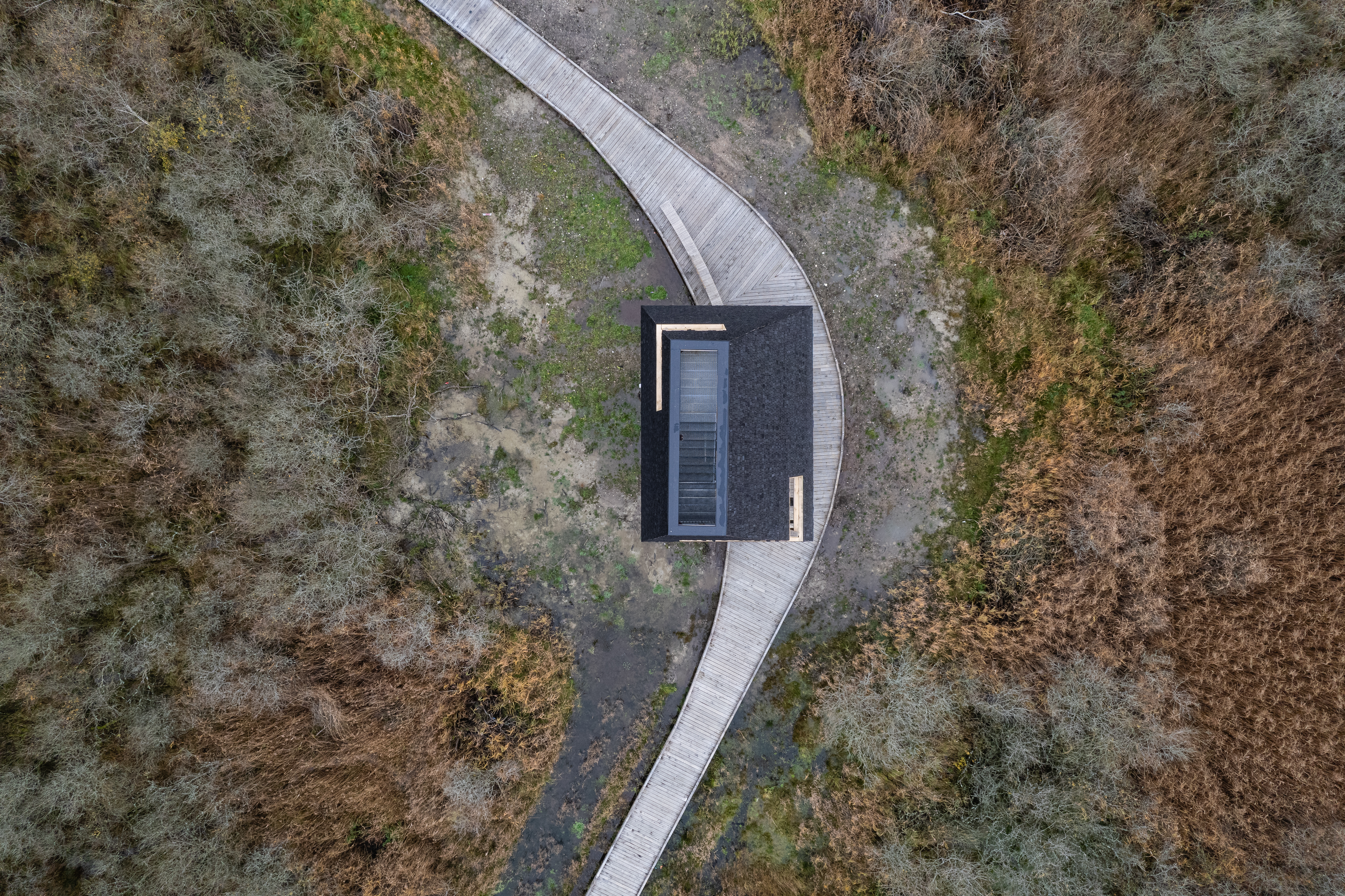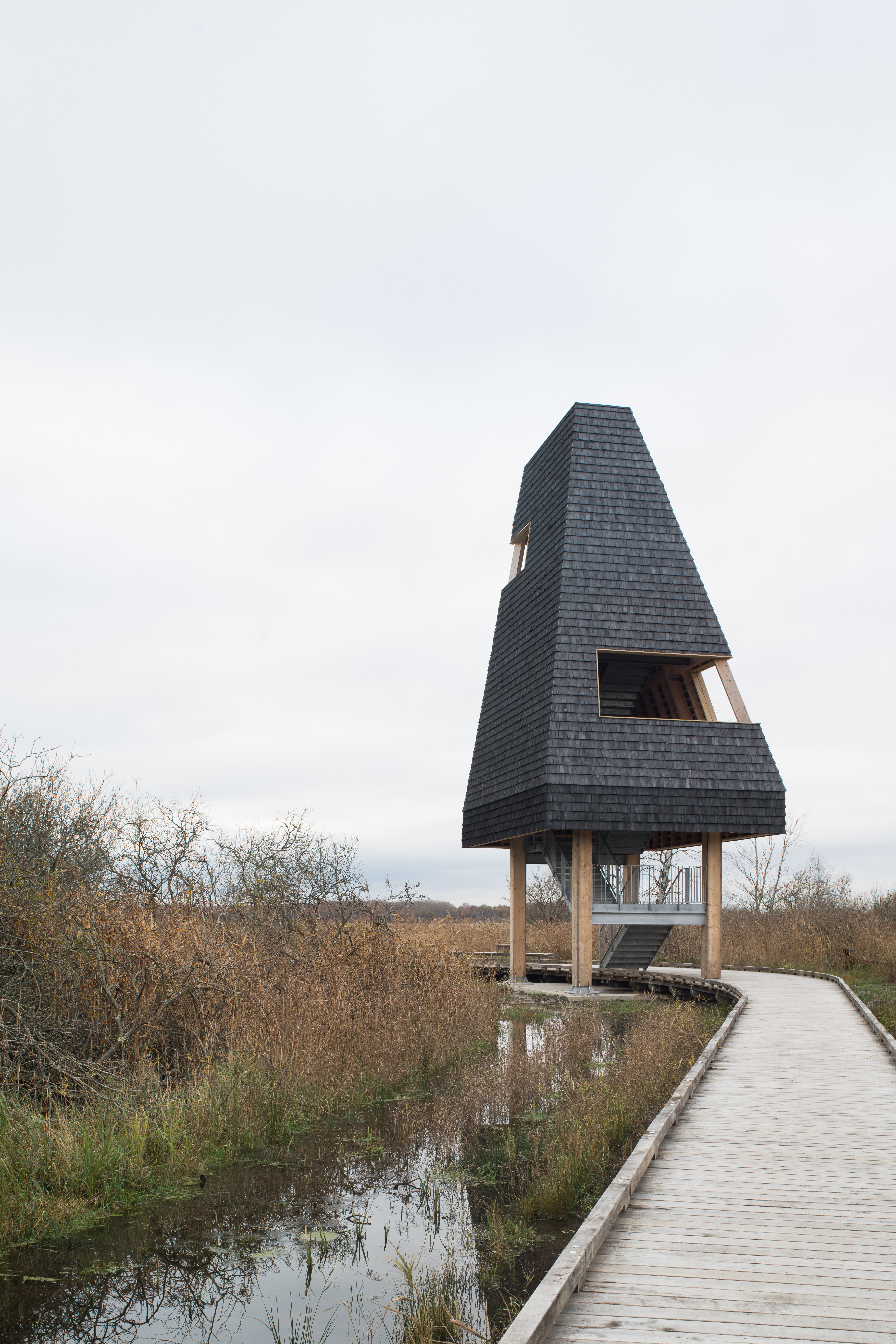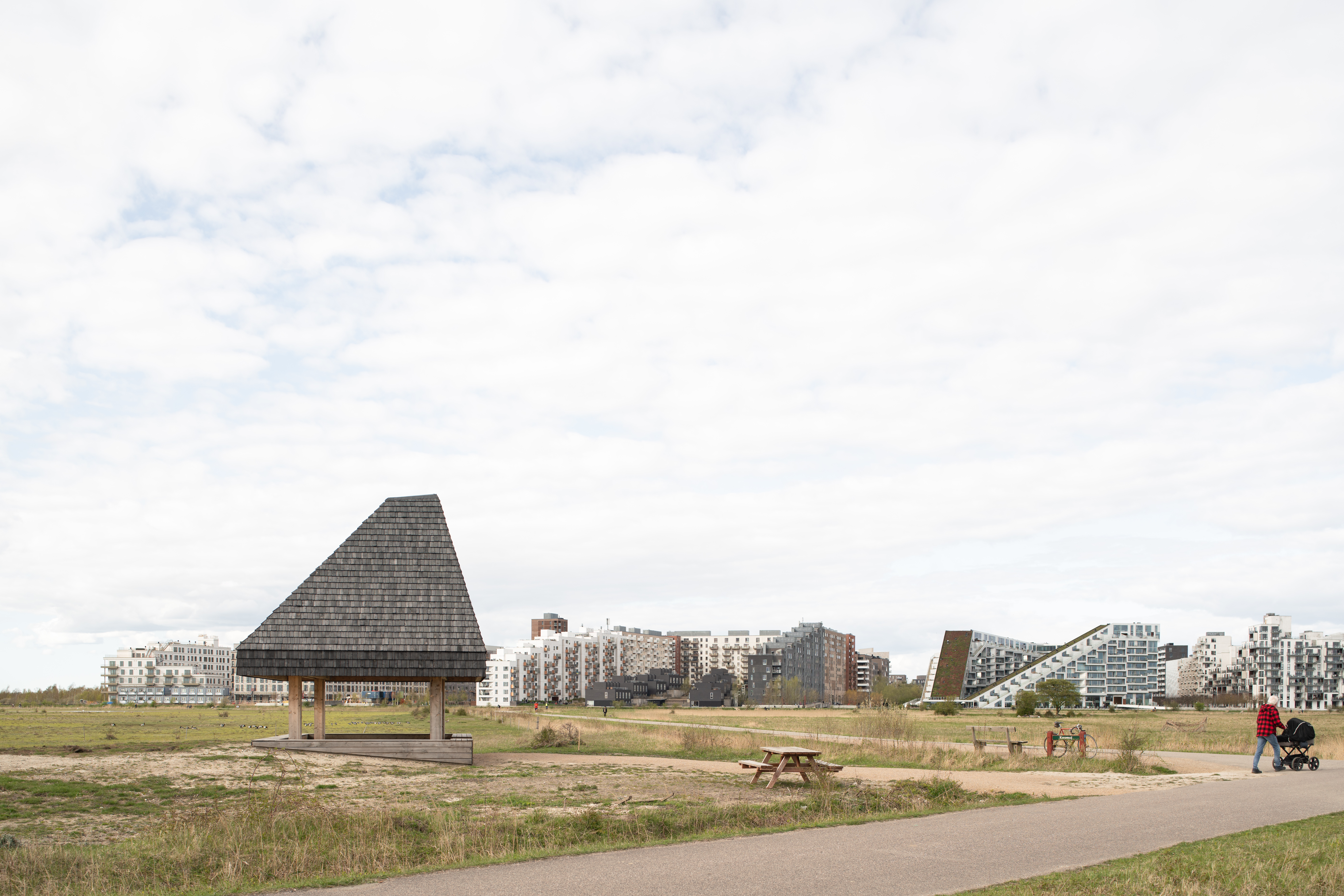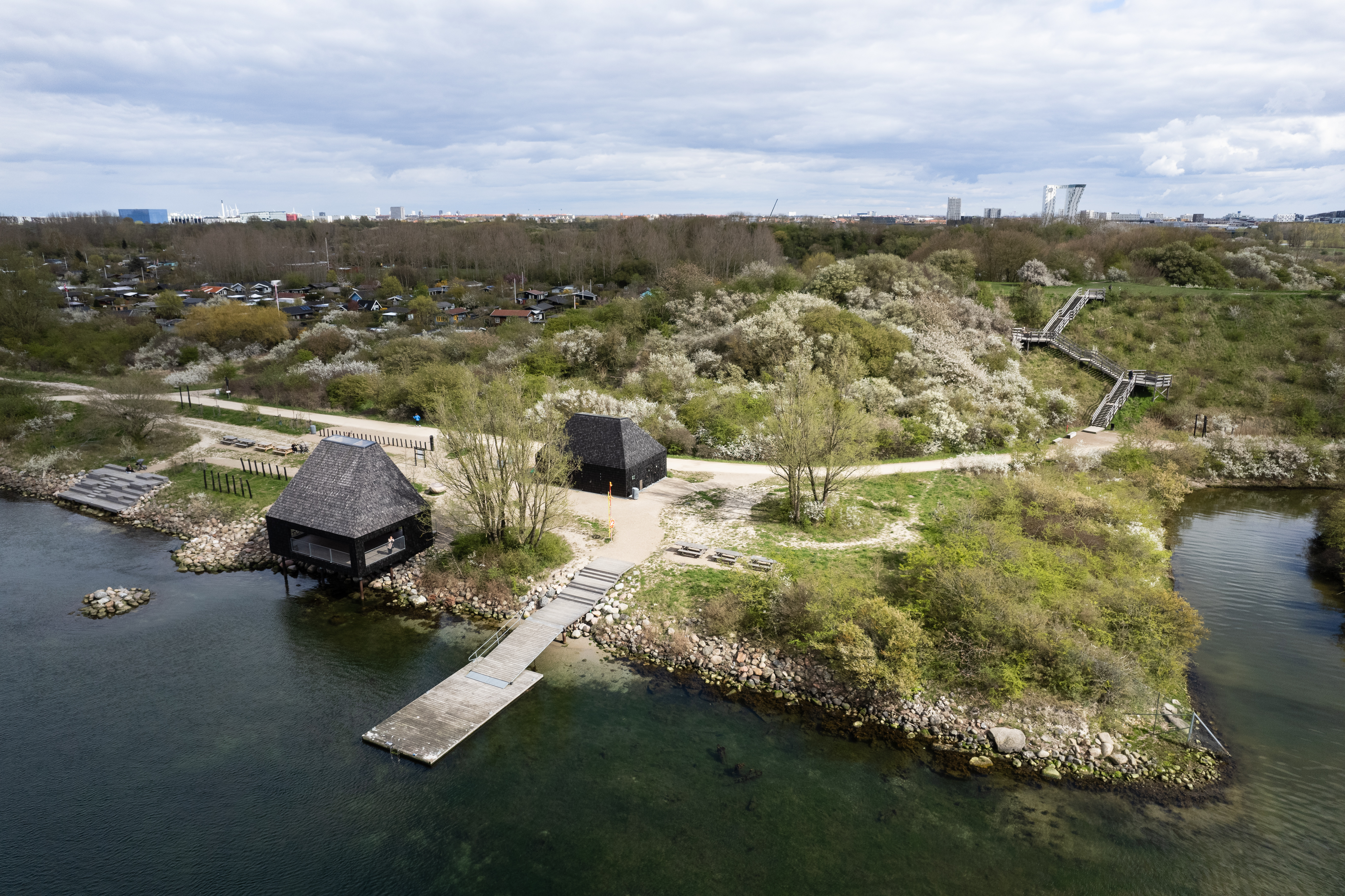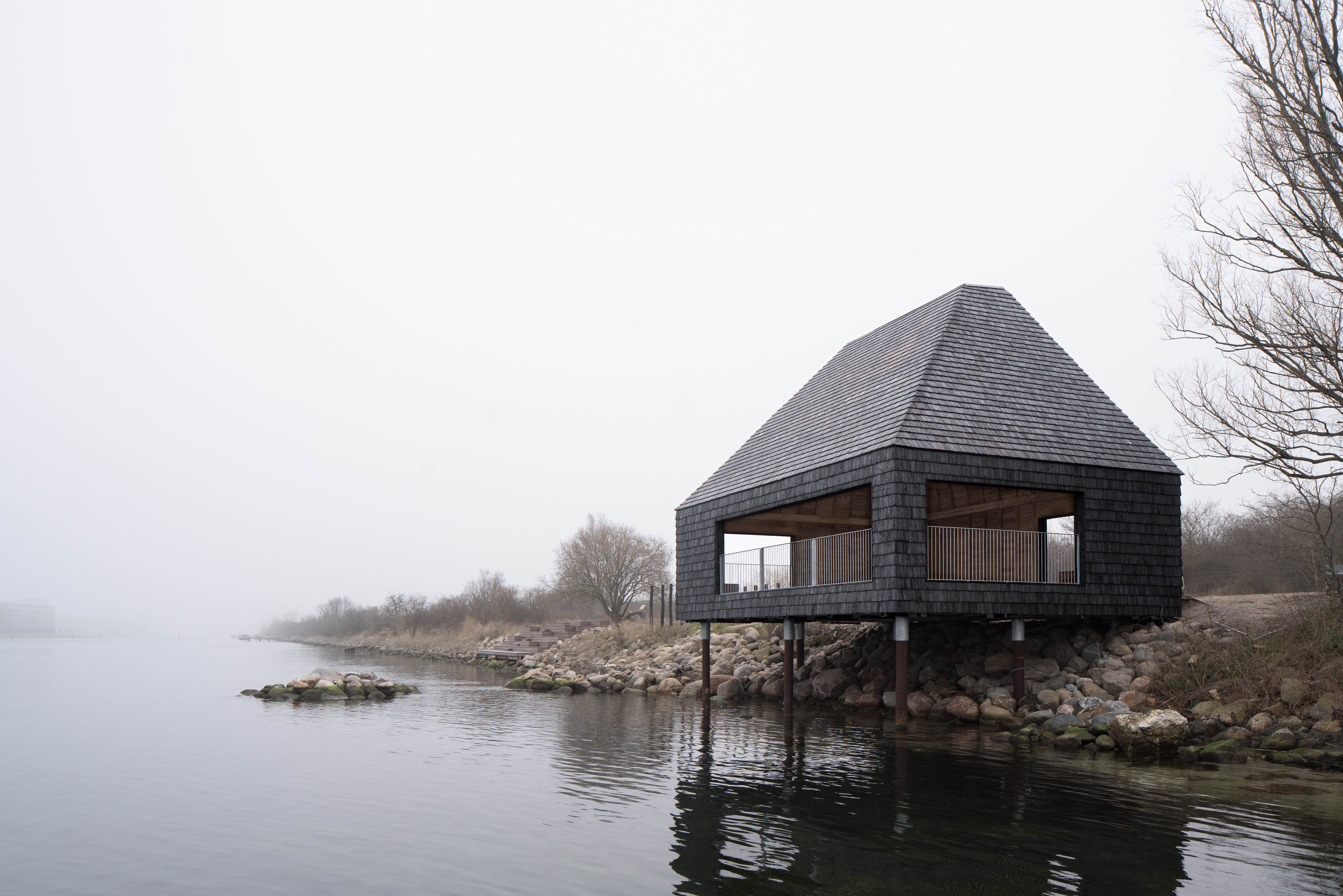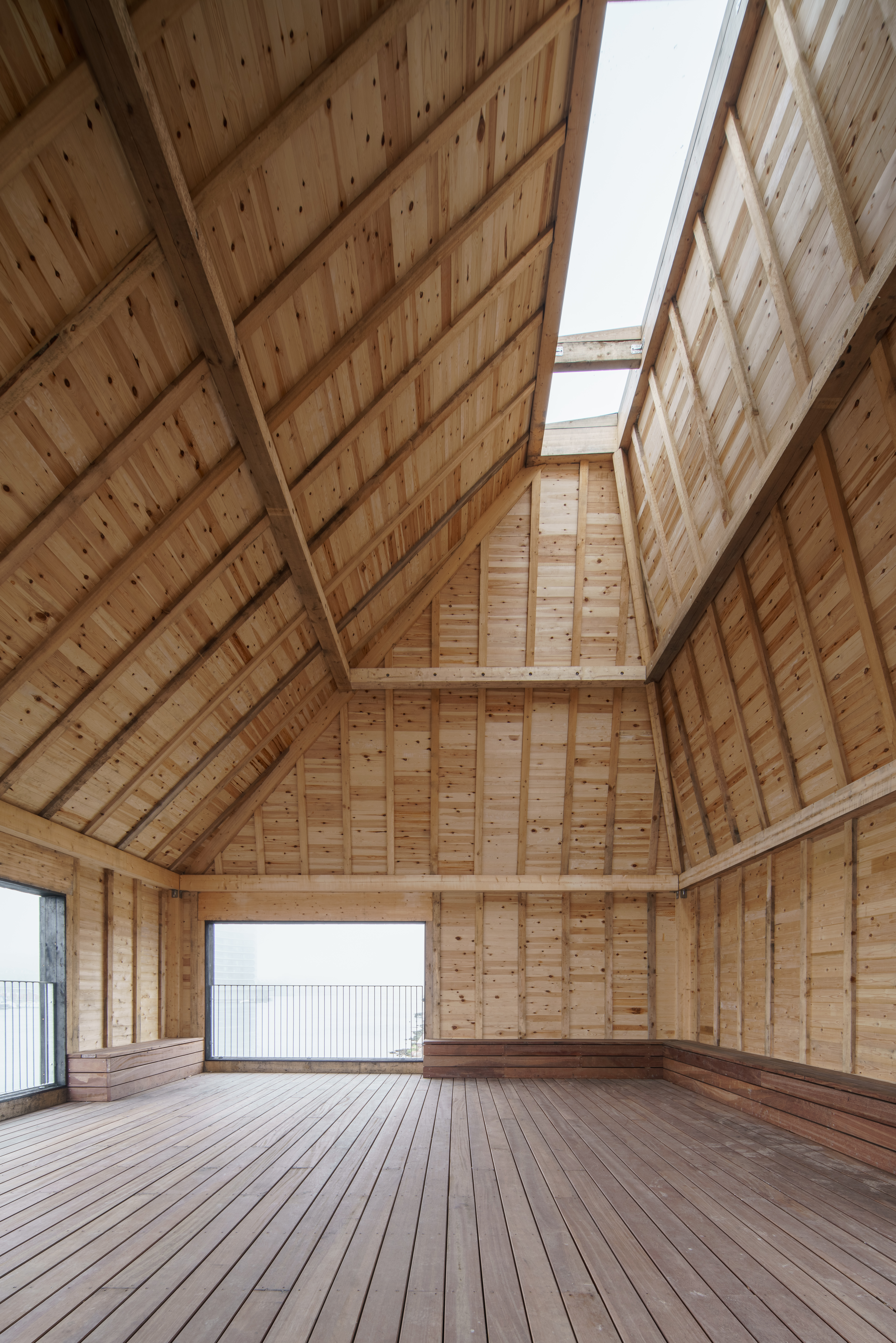Reconnecting with nature
Amager Nature Park
Amager Nature Park - a landscape park in Copenhagen
A breathtaking natural retreat, where 35 km² of protected landscapes, diverse wildlife, and a pristine coastline invite exploration. Thoughtfully redesigned to harmonize with its surroundings, the park features visitor points that seamlessly blend into nature, offering outdoor activities and peaceful escapes. Wooden structures, and boardwalks enhance accessibility while preserving the area's untouched beauty and ecological balance, ensuring a sustainable experience for generations to come.
Denmark
Regional
Amager region of Denmark, Copenhagen.
Mainly rural
It refers to a physical transformation of the built environment (hard investment)
Yes
2024-01-01
No
No
No
As a representative of an organisation
Amager Nature Park is a 35 km² sustainable urban nature project that integrates biodiversity conservation, accessibility, and community engagement to create an inclusive, climate-resilient green space. The park’s overall aim is to balance ecological preservation with public accessibility, ensuring that nature remains protected while offering high-quality recreational and educational experiences for all. The target groups include local residents, nature enthusiasts, students, elderly individuals, and people with disabilities, as well as the broader urban population benefiting from improved air quality, biodiversity, and climate resilience. The specific objectives include restoring natural habitats, minimizing environmental impact through sustainable infrastructure, and ensuring universal access with barrier-free pathways, sensory trails, and eco-friendly mobility solutions. The project also fosters community involvement, with citizens actively participating in conservation efforts, guided eco-education programs, and nature-based volunteering. Achieved outcomes include the restoration of native ecosystems, increased public engagement with over 100,000 visitors annually, the promotion of low-carbon mobility, and economic benefits through eco-tourism and job creation in conservation and education. By setting a new standard for inclusive, sustainable urban green spaces, Amager Nature Park serves as a scalable model for cities worldwide, demonstrating how nature, accessibility, and community-driven stewardship can create resilient, people-centered environments.
Biodiversity
Sustainability
Accessibility
Recreation
Conservation
The Amager Nature Park project sets a benchmark for sustainable urban development, balancing ecological preservation with public accessibility. Key sustainability goals and their implementation include:
Conserving natural habitats:
The park protects native flora and fauna through habitat restoration, ensuring biodiversity thrives in a minimally intrusive environment.
Sustainable materials and construction:
Infrastructure like pathways, boardwalks, and visitor hubs use eco-friendly, locally sourced materials that blend with the landscape.
Low-Impact infrastructure:
Designed to minimize disruption, the park integrates architecture into the natural surroundings, reducing artificial interventions while improving accessibility.
Renewable energy and resource efficiency:
Facilities utilize solar power, rainwater harvesting, and energy-efficient solutions, lowering the park’s carbon footprint.
Sustainable mobility:
The park promotes eco-friendly transport, featuring extensive cycling paths and pedestrian routes to reduce car dependency and CO₂ emissions.
Environmental awareness and education:
Interactive workshops, nature trails, and guided tours foster sustainability awareness, teaching visitors about conservation and ecological balance.
A model for sustainable urban green spaces:
Amager Nature Park exemplifies how cities can integrate nature without compromising ecological integrity. By combining sustainable infrastructure, responsible tourism, and biodiversity preservation, it demonstrates how urban green spaces can enhance climate resilience, social well-being, and economic growth. Its success offers a scalable model for cities worldwide looking to create sustainable, inclusive green spaces.
Conserving natural habitats:
The park protects native flora and fauna through habitat restoration, ensuring biodiversity thrives in a minimally intrusive environment.
Sustainable materials and construction:
Infrastructure like pathways, boardwalks, and visitor hubs use eco-friendly, locally sourced materials that blend with the landscape.
Low-Impact infrastructure:
Designed to minimize disruption, the park integrates architecture into the natural surroundings, reducing artificial interventions while improving accessibility.
Renewable energy and resource efficiency:
Facilities utilize solar power, rainwater harvesting, and energy-efficient solutions, lowering the park’s carbon footprint.
Sustainable mobility:
The park promotes eco-friendly transport, featuring extensive cycling paths and pedestrian routes to reduce car dependency and CO₂ emissions.
Environmental awareness and education:
Interactive workshops, nature trails, and guided tours foster sustainability awareness, teaching visitors about conservation and ecological balance.
A model for sustainable urban green spaces:
Amager Nature Park exemplifies how cities can integrate nature without compromising ecological integrity. By combining sustainable infrastructure, responsible tourism, and biodiversity preservation, it demonstrates how urban green spaces can enhance climate resilience, social well-being, and economic growth. Its success offers a scalable model for cities worldwide looking to create sustainable, inclusive green spaces.
Aesthetic and experiential excellence
Amager Nature Park seamlessly integrates natural beauty with minimalist architecture, enhancing visitor experiences while preserving the landscape’s authenticity. The project blends sustainability, aesthetics, and cultural enrichment to foster a deep connection with nature.
Harmonizing design with nature:
Structures like visitor points, shelters, and boardwalks use locally sourced wood and dark-burnt shingles, ensuring a seamless blend with the landscape. The design highlights natural textures and colors while maintaining a strong visual identity.
Enhancing visitor experience:
The park prioritizes human-scale experiences with intuitive layouts, scenic viewpoints, and immersive pathways. Thoughtfully placed seating areas and rest zones encourage exploration, relaxation, and engagement with nature.
Cultural and educational enrichment:
Outdoor classrooms, storytelling elements, and interactive trails promote environmental awareness and cultural appreciation. Seasonal festivals, workshops, and artistic installations further enhance the park’s educational and recreational value.
A model for sustainable and experiential Design:
By combining nature-integrated architecture with high-quality visitor experiences, Amager Nature Park sets a new standard for sustainable and immersive urban nature spaces.
Amager Nature Park seamlessly integrates natural beauty with minimalist architecture, enhancing visitor experiences while preserving the landscape’s authenticity. The project blends sustainability, aesthetics, and cultural enrichment to foster a deep connection with nature.
Harmonizing design with nature:
Structures like visitor points, shelters, and boardwalks use locally sourced wood and dark-burnt shingles, ensuring a seamless blend with the landscape. The design highlights natural textures and colors while maintaining a strong visual identity.
Enhancing visitor experience:
The park prioritizes human-scale experiences with intuitive layouts, scenic viewpoints, and immersive pathways. Thoughtfully placed seating areas and rest zones encourage exploration, relaxation, and engagement with nature.
Cultural and educational enrichment:
Outdoor classrooms, storytelling elements, and interactive trails promote environmental awareness and cultural appreciation. Seasonal festivals, workshops, and artistic installations further enhance the park’s educational and recreational value.
A model for sustainable and experiential Design:
By combining nature-integrated architecture with high-quality visitor experiences, Amager Nature Park sets a new standard for sustainable and immersive urban nature spaces.
Amager Nature Park is a welcoming, accessible, and affordable green space designed to ensure that nature is available to all, regardless of ability, background, or socio-economic status. It demonstrates how cities can integrate sustainability and social equity through:
Universal accessibility:
Step-free pathways, wheelchair-friendly boardwalks, and sensory trails enable exploration for all abilities. Tactile maps, audio guides, and clear wayfinding signage support visitors with visual or hearing impairments.
Affordability and open access – Free entry eliminates financial barriers, while public transport links, cycling paths, and pedestrian-friendly routes ensure low-cost, car-free access. Sheltered rest areas, picnic zones, and drinking water stations enhance comfort for all visitors.
Community participation:
Residents, environmental groups, and accessibility advocates contribute through stakeholder engagement, workshops, volunteer programs, and co-management initiatives. A public feedback system ensures continuous improvements based on diverse community needs.
Cultural and educational inclusion:
Multilingual guides, interactive installations, and nature trails make learning accessible. Outdoor classrooms and guided tours provide hands-on education, while seasonal events, festivals, and cultural activities foster a sense of community.
By prioritizing accessibility, affordability, and inclusive governance, Amager Nature Park serves as a replicable model for equitable urban green spaces, enhancing well-being for all.
Universal accessibility:
Step-free pathways, wheelchair-friendly boardwalks, and sensory trails enable exploration for all abilities. Tactile maps, audio guides, and clear wayfinding signage support visitors with visual or hearing impairments.
Affordability and open access – Free entry eliminates financial barriers, while public transport links, cycling paths, and pedestrian-friendly routes ensure low-cost, car-free access. Sheltered rest areas, picnic zones, and drinking water stations enhance comfort for all visitors.
Community participation:
Residents, environmental groups, and accessibility advocates contribute through stakeholder engagement, workshops, volunteer programs, and co-management initiatives. A public feedback system ensures continuous improvements based on diverse community needs.
Cultural and educational inclusion:
Multilingual guides, interactive installations, and nature trails make learning accessible. Outdoor classrooms and guided tours provide hands-on education, while seasonal events, festivals, and cultural activities foster a sense of community.
By prioritizing accessibility, affordability, and inclusive governance, Amager Nature Park serves as a replicable model for equitable urban green spaces, enhancing well-being for all.
Amager Nature Park ensures inclusivity, environmental stewardship, and shared ownership through public participation, civil society collaboration, and community-driven activities.
Public engagement and planning:
Surveys, workshops, and public meetings shaped accessibility, recreation, and conservation efforts. Feedback from residents and advocacy groups led to inclusive pathways and activity areas.
Collaboration with experts and organizations:
Environmental and disability advocacy groups guided conservation, accessibility, and sustainable infrastructure. Partnerships with cultural and educational institutions expanded learning programs.
Community stewardship:
Volunteers participate in reforestation, habitat restoration, and biodiversity monitoring. Local cleanups, gardening projects, and nature workshops encourage long-term engagement.
Impact and legacy:
Stronger Community Ownership - Increased care and involvement.
Improved Accessibility - Inclusive, universally designed spaces.
Sustainable Balance - Harmonizing conservation with recreation.
Ongoing Adaptation - Continuous refinement based on feedback.
A model for inclusive urban nature:
Through active public participation, Amager Nature Park exemplifies sustainable, community-driven urban green spaces.
Public engagement and planning:
Surveys, workshops, and public meetings shaped accessibility, recreation, and conservation efforts. Feedback from residents and advocacy groups led to inclusive pathways and activity areas.
Collaboration with experts and organizations:
Environmental and disability advocacy groups guided conservation, accessibility, and sustainable infrastructure. Partnerships with cultural and educational institutions expanded learning programs.
Community stewardship:
Volunteers participate in reforestation, habitat restoration, and biodiversity monitoring. Local cleanups, gardening projects, and nature workshops encourage long-term engagement.
Impact and legacy:
Stronger Community Ownership - Increased care and involvement.
Improved Accessibility - Inclusive, universally designed spaces.
Sustainable Balance - Harmonizing conservation with recreation.
Ongoing Adaptation - Continuous refinement based on feedback.
A model for inclusive urban nature:
Through active public participation, Amager Nature Park exemplifies sustainable, community-driven urban green spaces.
The transformation of Amager Nature Park was a collaborative effort involving local, regional, national stakeholders, each contributing to its sustainable design and implementation.
Local stakeholders - Copenhagen Municipality, communities, NGOs, Nordea fund - ensured the park met public needs while protecting biodiversity. Public consultations strengthened community ownership, while NGOs guided conservation efforts.
Regional bodies - Capital Region of Denmark, tourism & business groups like Nordea Fund- enhanced connectivity, economic opportunities, and accessibility, making the park a key recreational hub.
National agencies - Danish Government, environmental authorities, cultural institutions - secured regulatory compliance, funding, and heritage preservation.
This multi-level engagement ensured nature conservation, public accessibility, and long-term resilience, making Amager Nature Park a model for urban-nature integration.
Local stakeholders - Copenhagen Municipality, communities, NGOs, Nordea fund - ensured the park met public needs while protecting biodiversity. Public consultations strengthened community ownership, while NGOs guided conservation efforts.
Regional bodies - Capital Region of Denmark, tourism & business groups like Nordea Fund- enhanced connectivity, economic opportunities, and accessibility, making the park a key recreational hub.
National agencies - Danish Government, environmental authorities, cultural institutions - secured regulatory compliance, funding, and heritage preservation.
This multi-level engagement ensured nature conservation, public accessibility, and long-term resilience, making Amager Nature Park a model for urban-nature integration.
ADEPT + LYTT Architecture collaboration.
LYTT Architecture played a key role in shaping Amager Nature Park’s transformation, ensuring a seamless blend of landscape, architecture, and ecology.
Landscape Strategy: Designed site-specific visitor points with minimal environmental impact.
Accessibility and pathways: Developed boardwalks and trails to enhance access while protecting nature.
Ecological integration: Focused on nature-based solutions to balance recreation and conservation.
Unified design: Created a cohesive architectural identity with natural materials and subtle interventions.
This collaboration ensured Amager Nature Park remains an inviting, sustainable, and ecologically responsible space, setting a new standard for urban nature integration.
Interdisciplinary approach in Amager Nature Park
The project integrated multiple disciplines to balance nature conservation, visitor experience, and urban integration:
Landscape architecture an urban planning shaped the park’s layout for accessibility and seamless nature integration.
Ecology and environmental science ensured biodiversity protection and minimal human impact.
Architecture and sustainable design developed low-impact structures using eco-friendly materials.
Heritage and cultural studies preserved historical landscapes and local identity.
Social sciences and public engagement aligned the design with community needs through consultations.
Sustainability and climate adaptation incorporated EU-backed strategies for resilience and green infrastructure.
Added Value
Cross-disciplinary collaboration led to innovative solutions, such as elevated boardwalks to protect fragile habitats while enhancing accessibility. This holistic approach ensured Amager Nature Park remains a sustainable, inclusive, and ecologically responsible urban nature space.
LYTT Architecture played a key role in shaping Amager Nature Park’s transformation, ensuring a seamless blend of landscape, architecture, and ecology.
Landscape Strategy: Designed site-specific visitor points with minimal environmental impact.
Accessibility and pathways: Developed boardwalks and trails to enhance access while protecting nature.
Ecological integration: Focused on nature-based solutions to balance recreation and conservation.
Unified design: Created a cohesive architectural identity with natural materials and subtle interventions.
This collaboration ensured Amager Nature Park remains an inviting, sustainable, and ecologically responsible space, setting a new standard for urban nature integration.
Interdisciplinary approach in Amager Nature Park
The project integrated multiple disciplines to balance nature conservation, visitor experience, and urban integration:
Landscape architecture an urban planning shaped the park’s layout for accessibility and seamless nature integration.
Ecology and environmental science ensured biodiversity protection and minimal human impact.
Architecture and sustainable design developed low-impact structures using eco-friendly materials.
Heritage and cultural studies preserved historical landscapes and local identity.
Social sciences and public engagement aligned the design with community needs through consultations.
Sustainability and climate adaptation incorporated EU-backed strategies for resilience and green infrastructure.
Added Value
Cross-disciplinary collaboration led to innovative solutions, such as elevated boardwalks to protect fragile habitats while enhancing accessibility. This holistic approach ensured Amager Nature Park remains a sustainable, inclusive, and ecologically responsible urban nature space.
Amager Nature Park goes beyond conventional urban green spaces by integrating sustainability, accessibility, and community-driven design, creating a holistic model for ecological and social inclusion.
Seamless urban-nature integration:
Unlike traditional parks, it connects city and nature, ensuring equal access while preserving biodiversity.
Transition zones between land and water offer a unique, immersive experience.
Universal accessibility:
Barrier-free pathways, sensory trails, and inclusive wayfinding set a new standard for accessibility.
Designed for people of all abilities, unlike most parks that overlook disability inclusion.
Sustainable, Low-Impact Infrastructure:
Uses locally sourced materials, solar power, and rainwater harvesting, minimizing its footprint.
Blends architecture with nature, unlike conventional developments that dominate landscapes.
Community-led Design and sewardship:
Co-created with citizens, environmental groups, and accessibility advocates for relevance and inclusivity.
Volunteer programs, rewilding efforts, and educational initiatives ensure ongoing public engagement.
A new standard for urban green spaces:
Amager Nature Park sets a replicable model for cities, proving that sustainability, accessibility, and community ownership can redefine urban nature.
Seamless urban-nature integration:
Unlike traditional parks, it connects city and nature, ensuring equal access while preserving biodiversity.
Transition zones between land and water offer a unique, immersive experience.
Universal accessibility:
Barrier-free pathways, sensory trails, and inclusive wayfinding set a new standard for accessibility.
Designed for people of all abilities, unlike most parks that overlook disability inclusion.
Sustainable, Low-Impact Infrastructure:
Uses locally sourced materials, solar power, and rainwater harvesting, minimizing its footprint.
Blends architecture with nature, unlike conventional developments that dominate landscapes.
Community-led Design and sewardship:
Co-created with citizens, environmental groups, and accessibility advocates for relevance and inclusivity.
Volunteer programs, rewilding efforts, and educational initiatives ensure ongoing public engagement.
A new standard for urban green spaces:
Amager Nature Park sets a replicable model for cities, proving that sustainability, accessibility, and community ownership can redefine urban nature.
The Amager Nature Park project follows an integrated, participatory, and sustainable approach, ensuring a balance between ecological preservation, accessibility, and urban connectivity. The methodology is structured around four key pillars:
Participatory and user-centered design:
Co-creation with citizens, environmental groups, and accessibility advocates ensures the park meets diverse needs.
Workshops, surveys, and public consultations shaped infrastructure, visitor points, and wayfinding systems.
Feedback loops allow continuous improvements based on user experience.
Nature-based and low-Impact design:
Minimal intervention philosophy preserves biodiversity while enhancing accessibility.
Locally sourced materials, renewable energy, and water-sensitive design reduce environmental impact.
Transition zones between city, land, and water create a seamless experience while protecting fragile ecosystems.
Accessibility and inclusive Infrastructure:
Universal design principles ensure wheelchair-friendly paths, sensory trails, and inclusive facilities.
Clear wayfinding, tactile maps, and multilingual guides make the park accessible to all.
Public transport and cycling-friendly access promote sustainable mobility.
Community engagement and stewardship:
Volunteers and local organizations participate in rewilding, habitat restoration, and maintenance.
Educational programs, guided tours, and nature workshops promote sustainability awareness.
Adaptive governance ensures that evolving community needs are met over time.
A scalable and replicable model
By combining participatory planning, ecological sensitivity, and inclusive design, Amager Nature Park serves as a global model for sustainable and people-centered urban nature development.
Participatory and user-centered design:
Co-creation with citizens, environmental groups, and accessibility advocates ensures the park meets diverse needs.
Workshops, surveys, and public consultations shaped infrastructure, visitor points, and wayfinding systems.
Feedback loops allow continuous improvements based on user experience.
Nature-based and low-Impact design:
Minimal intervention philosophy preserves biodiversity while enhancing accessibility.
Locally sourced materials, renewable energy, and water-sensitive design reduce environmental impact.
Transition zones between city, land, and water create a seamless experience while protecting fragile ecosystems.
Accessibility and inclusive Infrastructure:
Universal design principles ensure wheelchair-friendly paths, sensory trails, and inclusive facilities.
Clear wayfinding, tactile maps, and multilingual guides make the park accessible to all.
Public transport and cycling-friendly access promote sustainable mobility.
Community engagement and stewardship:
Volunteers and local organizations participate in rewilding, habitat restoration, and maintenance.
Educational programs, guided tours, and nature workshops promote sustainability awareness.
Adaptive governance ensures that evolving community needs are met over time.
A scalable and replicable model
By combining participatory planning, ecological sensitivity, and inclusive design, Amager Nature Park serves as a global model for sustainable and people-centered urban nature development.
Amager Nature Park offers a scalable model for integrating sustainability, accessibility, and community engagement into urban nature projects. Several key elements can be adapted to different locations and beneficiary groups.
Participatory and community-driven planning:
The project’s stakeholder engagement process, including citizens, NGOs, and accessibility groups, ensures inclusivity. Workshops, surveys, and co-creation sessions shape infrastructure and park functions. This model suits urban renewal projects, community parks, and nature reserves aiming for public-driven design.
Universal accessibility a inclusive infrastructure:
Barrier-free pathways, tactile maps, and multilingual wayfinding ensure full accessibility. Cycling infrastructure and public transport integration reduce car dependency. This approach benefits cities enhancing public spaces for all users and eco-tourism destinations promoting inclusivity.
Sustainable, Low-Impact Design:
The park uses locally sourced materials, solar power, and rainwater harvesting to minimize its environmental footprint. Its minimal-intervention architecture suits coastal, forest, and urban parks focusing on climate resilience.
Nature-based education and community stewardship:
Outdoor classrooms, interactive trails, and volunteer-led conservation programs foster environmental awareness. This model is adaptable for schools, universities, and eco-parks promoting sustainability education.
A scalable model for urban green spaces:
By blending accessibility, sustainability, and public participation, Amager Nature Park presents a replicable approach for inclusive and climate-resilient urban nature projects worldwide.
Participatory and community-driven planning:
The project’s stakeholder engagement process, including citizens, NGOs, and accessibility groups, ensures inclusivity. Workshops, surveys, and co-creation sessions shape infrastructure and park functions. This model suits urban renewal projects, community parks, and nature reserves aiming for public-driven design.
Universal accessibility a inclusive infrastructure:
Barrier-free pathways, tactile maps, and multilingual wayfinding ensure full accessibility. Cycling infrastructure and public transport integration reduce car dependency. This approach benefits cities enhancing public spaces for all users and eco-tourism destinations promoting inclusivity.
Sustainable, Low-Impact Design:
The park uses locally sourced materials, solar power, and rainwater harvesting to minimize its environmental footprint. Its minimal-intervention architecture suits coastal, forest, and urban parks focusing on climate resilience.
Nature-based education and community stewardship:
Outdoor classrooms, interactive trails, and volunteer-led conservation programs foster environmental awareness. This model is adaptable for schools, universities, and eco-parks promoting sustainability education.
A scalable model for urban green spaces:
By blending accessibility, sustainability, and public participation, Amager Nature Park presents a replicable approach for inclusive and climate-resilient urban nature projects worldwide.
Amager Nature Park tackles pressing global challenges through local, scalable solutions, demonstrating how urban green spaces can promote sustainability, resilience, and social inclusion.
Climate change and urban resilience:
Challenge: Cities face rising temperatures, extreme weather, and biodiversity loss due to urbanization.
Local Solution: The park integrates nature-based solutions, including coastal protection, reforestation, and wetland restoration, enhancing climate resilience while reducing carbon emissions through sustainable mobility and renewable energy use.
Loss of biodiversity and ecosystem degradation:
Challenge: Urban expansion threatens natural habitats and wildlife.
Local Solution: By preserving and restoring diverse ecosystems, the park ensures biodiversity conservation while creating habitat corridors that support flora and fauna. Low-impact infrastructure allows nature to flourish alongside public use.
Social Inequality and limited access to green spaces:
Challenge: Many urban residents, especially marginalized groups, lack access to public green spaces.
Local Solution: The park provides free, universally accessible nature experiences, integrating wheelchair-friendly pathways, sensory trails, and public transit access to ensure inclusion for all.
Disconnection from nature and environmental awareness:
Challenge: Rapid urbanization limits nature exposure, leading to reduced environmental consciousness.
Local Solution: The park promotes hands-on education through outdoor classrooms, guided eco-tours, and citizen-led conservation programs, fostering a culture of sustainability.
A scalable model for global urban challenges:
Amager Nature Park demonstrates how local action can drive global impact, offering a replicable, nature-based solution to climate resilience, biodiversity loss, social inclusion, and sustainability education in cities worldwide.
Climate change and urban resilience:
Challenge: Cities face rising temperatures, extreme weather, and biodiversity loss due to urbanization.
Local Solution: The park integrates nature-based solutions, including coastal protection, reforestation, and wetland restoration, enhancing climate resilience while reducing carbon emissions through sustainable mobility and renewable energy use.
Loss of biodiversity and ecosystem degradation:
Challenge: Urban expansion threatens natural habitats and wildlife.
Local Solution: By preserving and restoring diverse ecosystems, the park ensures biodiversity conservation while creating habitat corridors that support flora and fauna. Low-impact infrastructure allows nature to flourish alongside public use.
Social Inequality and limited access to green spaces:
Challenge: Many urban residents, especially marginalized groups, lack access to public green spaces.
Local Solution: The park provides free, universally accessible nature experiences, integrating wheelchair-friendly pathways, sensory trails, and public transit access to ensure inclusion for all.
Disconnection from nature and environmental awareness:
Challenge: Rapid urbanization limits nature exposure, leading to reduced environmental consciousness.
Local Solution: The park promotes hands-on education through outdoor classrooms, guided eco-tours, and citizen-led conservation programs, fostering a culture of sustainability.
A scalable model for global urban challenges:
Amager Nature Park demonstrates how local action can drive global impact, offering a replicable, nature-based solution to climate resilience, biodiversity loss, social inclusion, and sustainability education in cities worldwide.
Amager Nature Park has delivered significant environmental, social, and economic benefits, aligning with the goals of sustainable urban development, biodiversity conservation, and inclusive green spaces.
Environmental Impact:
Restored natural habitats across 35 km², enhancing biodiversity and ecological resilience.
Improved air quality and carbon sequestration through reforestation and wetland conservation.
Sustainable infrastructure, including solar-powered facilities and rainwater harvesting, reducing the park’s carbon footprint.
Social and accessibility outcomes:
Universal accessibility features, such as wheelchair-friendly pathways, sensory trails, and inclusive wayfinding, ensure nature is open to all.
Increased public engagement, with over 100,000 visitors annually, including families, elderly individuals, and people with disabilities.
Free educational programs, outdoor classrooms, and guided nature tours enhance environmental awareness.
Economic and community benefits:
Boosted local economy by attracting eco-tourism and supporting small businesses around the park.
Created jobs in conservation, education, and park management, strengthening local employment.
Citizen participation programs, including volunteer-led conservation initiatives and community stewardship projects, foster long-term public involvement.
Direct and indirect beneficiaries
Direct: Local residents, nature enthusiasts, students, and people with disabilities who benefit from improved access and recreational opportunities.
Indirect: The broader urban population benefits from cleaner air, climate resilience, and increased biodiversity, while cities worldwide can replicate the park’s sustainable model.
A scalable and inclusive model
Amager Nature Park has proven that sustainability, accessibility, and public engagement can coexist, setting a new benchmark for urban green spaces while addressing global environmental and social challenges
Environmental Impact:
Restored natural habitats across 35 km², enhancing biodiversity and ecological resilience.
Improved air quality and carbon sequestration through reforestation and wetland conservation.
Sustainable infrastructure, including solar-powered facilities and rainwater harvesting, reducing the park’s carbon footprint.
Social and accessibility outcomes:
Universal accessibility features, such as wheelchair-friendly pathways, sensory trails, and inclusive wayfinding, ensure nature is open to all.
Increased public engagement, with over 100,000 visitors annually, including families, elderly individuals, and people with disabilities.
Free educational programs, outdoor classrooms, and guided nature tours enhance environmental awareness.
Economic and community benefits:
Boosted local economy by attracting eco-tourism and supporting small businesses around the park.
Created jobs in conservation, education, and park management, strengthening local employment.
Citizen participation programs, including volunteer-led conservation initiatives and community stewardship projects, foster long-term public involvement.
Direct and indirect beneficiaries
Direct: Local residents, nature enthusiasts, students, and people with disabilities who benefit from improved access and recreational opportunities.
Indirect: The broader urban population benefits from cleaner air, climate resilience, and increased biodiversity, while cities worldwide can replicate the park’s sustainable model.
A scalable and inclusive model
Amager Nature Park has proven that sustainability, accessibility, and public engagement can coexist, setting a new benchmark for urban green spaces while addressing global environmental and social challenges

